2. Southwest Asia
The Southwest Asian region holds huge markets, including that of India, and has enormous economic potential, as its future economic growth and increasing demand for infrastructure is expected. It is also a strategically important region for realizing a “Free and Open Indo-Pacific” because of its location on land routes and sea lanes that connect East Asia with the Middle East. In addition, this region plays a large role in international efforts against terrorism and violent extremism.
At the same time, the Southwest Asian region still faces many issues that must be addressed. These issues include a lack of infrastructure such as roads, railroads, ports, and water and sewer systems, as well as growing populations, response against natural disasters, inadequate primary education, healthcare and medical systems, and unconsolidated rule of law. In particular, poverty reduction is a major challenge, with approximately one-third of the world’s poor said to be living in this region Note 5. Japan provides wide-ranging assistance in order to harness the economic potential of Southwest Asia as well as to address the growing gap between the rich and the poor.
●Japan’s Efforts
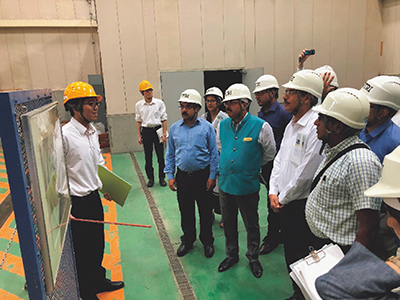
Officials of the Ministry of Railways and Dedicated Freight Corridor Corporation of India Limited visiting the Railway Technical Research Institute through a training program in Japan under the technical cooperation “Project for Capacity Development on Railway Safety” for India
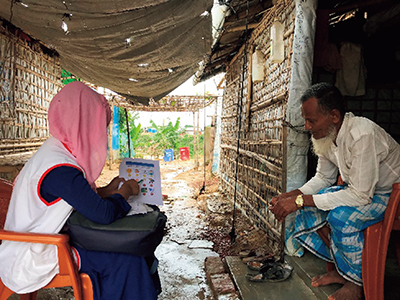
A displaced person engaging in informational activities on the prevention of COVID-19 after having received training as a volunteer at a camp for displaced persons in Bangladesh (Photo: UNHCR) (see also “Stories from the Field”)
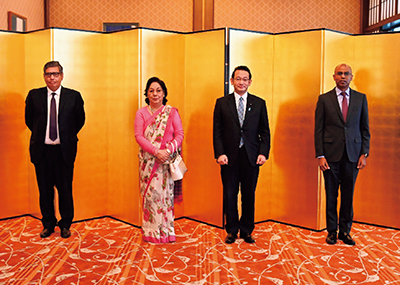
Parliamentary Vice-Minister for Foreign Affairs KOKUBA Konosuke after holding a luncheon and exchange of opinions with the Ambassadors of Nepal, Pakistan, and the Maldives (December 2020)
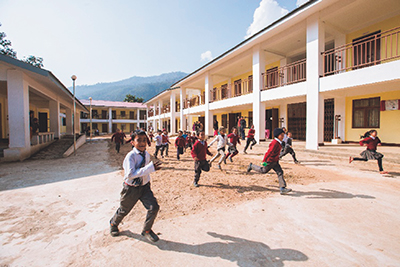
School children of Nepal running around cheerfully in the schoolyard in front of a new earthquake-resilient school building
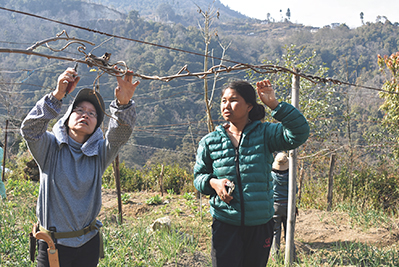
A JICA expert providing instruction on pruning kiwi vines at a model fruit farm through the “Integrated Horticulture Promotion Project in the West Central Region” in Bhutan (Photo: JICA)
In 2020, in the wake of the global spread of COVID-19, Japan has provided a combination of assistance including the utilization of emergency support loans, provision of equipment through grant aid, support through international organizations, and technical cooperation for Southwest Asian countries aimed at the region’s self-sustaining financial, economic, and social improvement over the medium to long-term. For instance, Japan began providing the COVID-19 Crisis Response Emergency Support Loan to India, Bangladesh, and the Maldives, in order to contribute to recovery, stability, and sustainable development of their societies and economies, alongside suppressing the spread of the disease. Additionally, Japan decided on grant aid for the provision of medical equipment for the Southwest Asian countries based on the needs of each country and will continue such efforts.
In India, a major country in the Southwest Asian region, the number of COVID-19 infections has spiked rapidly. Responding to the spread of infections in India, in August 2020, Japan exchanged notes with India on ¥50 billion for the COVID-19 Crisis Response Emergency Support Loan as budgetary support in the health sector and ¥1 billion in grant aid for the provision of medical equipment. Furthermore, by August 2020, Japan had exchanged notes with Bangladesh as well on ¥35 billion in budgetary support in the health sector through the COVID-19 Crisis Response Emergency Support Loan and ¥1 billion in grant aid for the provision of medical equipment.
Japan also exchanged notes with the Maldives on ¥5 billion for the COVID-19 Crisis Response Emergency Support Loan and ¥600 million in grant aid for the provision of medical equipment. Japan decided to provide similar grant aid for Sri Lanka and Pakistan as well, exchanging notes for ¥800 million and ¥1 billion in grant aid respectively. Furthermore, grant aid worth a total of ¥300 million is also being provided for provision of medical equipment in both Nepal and Bhutan respectively. In addition to such support, Japan is also providing assistance through international organizations for countries in the Southwest Asian region.
Regarding India, a key player in Southwest Asia, the leaders of Japan and India make mutual visits to each other’s country, and Japan promotes cooperation in a wide range of fields based on the “Special Strategic and Global Partnership.” These include economic cooperation as well as cooperation in a wide range of fields such as politics and security, economy, and academic exchanges. In recent years, India has been the largest recipient of Japan’s ODA loans, and Japan has provided assistance to India for the development of economic and social infrastructure, including in the fields of electric power and transport, which will contribute to enhancing connectivity and strengthening industrial competitiveness. In addition to this, as part of supporting its sustainable and inclusive growth, Japan is providing support to the forestry sector, which is instrumental in improving livelihoods, and support that helps to improve health and hygiene environments.
In March 2020, notes were exchanged to provide a total of nine ODA loans, including for metro construction in Ahmedabad and Mumbai and forestry sector projects engaged in global issues such as the conservation of biodiversity and climate change.
Furthermore, during a summit telephone talk in September 2020, Japan and India confirmed they would steadily proceed with the development plan for the Mumbai-Ahmedabad High Speed Rail (MAHSR) and continue to collaborate closely. If the project is realized, it is expected to shorten the travel time between Mumbai and Ahmedabad, which is currently at least seven hours by express train, to two hours, and the train fare is expected to be roughly half of that of the corresponding airfare.
In this way, Japan’s ODA plays a significant role in the growth of India, through assistance in a variety of fields, including health and medical care improvements, infrastructure development, measures to combat poverty, development of the investment environment, and human resources development, among others.
With regard to Bangladesh, where there has been remarkable growth and an increase in the number of Japanese companies operating business in recent years, Japan seeks to further advance the Japan-Bangladesh Comprehensive Partnership and promote development cooperation under the “Bay of Bengal Industrial Growth Belt (BIG-B)” initiative. The three pillars of the initiative are: (i) development of economic infrastructure, (ii) improvement of the investment environment, and (iii) enhancing connectivity. In May 2019, when Prime Minister Hasina of Bangladesh visited Japan, then Prime Minister Abe stated that Japan would continue to support Bangladesh in its efforts to achieve the SDGs and realize its vision of becoming a middle-income country by 2021. Former Prime Minister Abe also expressed his expectations for the advancement of the BIG-B initiative, as well as for the expansion of the exchanges of people and the further promotion of trade and investment between the two countries, reconfirming this direction during a summit telephone talk in August 2020. Based on these agreements between the two leaders, in August 2020, Japan and Bangladesh signed and exchanged notes concerning the provision of ODA loans for a total of seven projects: “Dhaka Mass Rapid Transit Development Project (IV),” “Dhaka Mass Rapid Transit Development Project (Line 5 Northern Route) (I),” “Jamuna Railway Bridge Construction Project (II),” “Hazrat Shahjalal International Airport Expansion Project (II),” “Chattogram-Cox’s Bazar Highway Improvement Project (E/S),” “Food Value Chain Improvement Project,” and “Urban Development and City Governance Project,” which are to contribute to enhanced connectivity within Bangladesh and the region as well as the development of economic infrastructure.
Furthermore, in 2020, Japan provided assistance to Bangladesh aimed at supporting the displaced persons flowing into the country from Rakhine State in Myanmar following the deterioration of public safety since the attacks in August 2017, as well as their host communities bearing this heavy burden, with approximately ¥2.828 billion in areas such as water and sanitation, nutrition, health and medical care, women’s protection, education, and vocational training through international organizations (see also “Stories from the Field”). Additionally, Japan has been providing support through the Japan Platform (JPF) for Japanese NGOs to deliver life-saving humanitarian assistance including distributing food and non-food items to survive, improving hygiene and sanitation, providing medical treatment, and protecting women and children.
Sri Lanka, which is located in a strategic position along sea lanes connecting Asia with the Middle East and Africa, has traditionally been a country that is friendly toward Japan. Japan is working on strengthening cooperation between the two countries, particularly in the fields of enhancing connectivity and maritime matters, toward the realization of a “Free and Open Indo-Pacific.” In addition, Japan continues to provide support in the field of infrastructure development, including airports, roads, and electric power, which contributes to quality development in Sri Lanka as well as to improvements in the business environment for Japanese companies operating in the country. Moreover, considering Sri Lanka’s history of conflict and the current situation of increased disparity, Japan also continues to carry out assistance to cope with natural disasters and provides cooperation including for livelihood improvement as well as industrial and human resources development with a focus on the agricultural sector for regions that are lagging behind in development. In July 2020, Japan and Sri Lanka exchanged notes regarding ¥200 million in grant aid for the provision of equipment for anti-illegal drug measures and ¥300 million in grant aid for the provision of food aid (approximately 388 tons of canned fish produced in areas affected by the Great East Japan earthquake) in collaboration with the World Food Programme (WFP).
The Maldives, same as Sri Lanka, is located in a strategic position along the sea lanes of the Indian Ocean and holds geopolitical importance for Japan. Then Foreign Minister Kono visited the Maldives in January 2018, and President Solih and Foreign Minister Shahid of the Maldives visited Japan together in October 2019, holding a summit meeting and a Foreign Ministers Meeting where they agreed that both countries would cooperate toward the realization of a “Free and Open Indo-Pacific.” Based on this policy, in 2020, it was decided to extend grant aid of ¥500 million for the provision of related equipment to build capacity in counter-terrorism and public safety measures (police vehicles, liquid inspection apparatus, portable x-ray devices for the detection of suspicious items, etc.), and ¥800 million for the provision of marine safety equipment to improve marine rescue and relief capabilities (telecommunications and diving-related equipment, etc.). Moreover, Japan also supported the Project for Human Resource Development Scholarship that provided the tuition and other expenses necessary for young government officials from the Maldives to obtain degrees in Japan.
Pakistan plays a vital role in the international community’s efforts to eradicate terrorism. In Pakistan, Japan has thus far been implementing improvements for its capabilities of security at airports and seaports, provisions of equipment and products in the fields of peacebuilding and counter-terrorism, the strengthening of border control capacity with respect to illegal drug trafficking and international organized crime, and support for the people that were internally displaced as a result of military operations to eliminate terrorists. Furthermore, Japan also provides support in the field of healthcare, such as the procurement of vaccines needed to eradicate polio in Pakistan. Additionally, Japan is continuously supporting the area of education, and in October 2020, notes on ¥471 million in grant aid were exchanged for the strengthening of disaster risk reduction measures in Khyber Pakhtunkhwa province in collaboration with United Nations Human Settlements Programme (UN-Habitat), including the earthquake proofing of schools and disaster risk reduction education.
In the aftermath of the major earthquake that struck Nepal in 2015, Japan implemented Emergency Grant Aid amounting to $14 million (¥1.68 billion) through eight international organizations. Moreover, to assist Nepal’s medium to long-term reconstruction process, Japan is providing support on a scale totaling approximately $260 million (over ¥32 billion) to rebuild houses (approximately 90,000 in total) and schools (approximately 280 in total). Furthermore, to build a resilient Nepal and overcome its vulnerabilities to disaster, Japan is also providing a range of technical support related to strengthening the government’s disaster risk reduction capabilities and the widespread adoption of buildings in line with construction standards. In 2020, to support Nepal’s efforts in consolidating and developing its democracy through the new Constitution, Japan is providing support to improve the governance capacity of the central and local governments. In addition, Japan has provided support to the Government of Nepal’s “School Sector Development Programme” in order to narrow educational gaps. Japan also provided support for the Project for Human Resource Development Scholarship by covering the tuition and other expenses required for young government officials from Nepal to obtain degrees in Japan. Furthermore, in collaboration with the WFP, Japan also decided on ¥352 million in grant aid related to the improvement of facilities to provide school meals using a local production for local consumption Note 6 system and capacity building for the spread of school meals in Nuwakot District.
Furthermore, Japan has built cordial relations with Bhutan since the establishment of diplomatic relations in 1986 and celebrated the 30th anniversary of the establishment of diplomatic relations between the two countries in 2016. In January 2020, the ODA research mission of the House of Councillors of the National Diet of Japan for FY2019 was dispatched to the country, during which the mission inspected the current state of assistance in the areas of agriculture and health, had an audience with His Majesty Jigme Khesar Namgyel Wangchuck, King of Bhutan, and held an exchange of opinions with Prime Minister Dr. Lotay Tshering, Minister for Foreign Affairs Dr. Tandi Dorji, and Chairperson of the National Council Hon. Tashi Dorji, among others. Japan’s development cooperation toward Bhutan serves as the foundation for friendly relations between the two countries. As such, Japan has been providing support while respecting Bhutan’s National Development Plan that focuses on the country’s fundamental philosophy of maximizing Gross National Happiness (GNH). This support has achieved steady results, especially in fields such as the improvement of agricultural productivity, development of economic infrastructure such as road networks and bridges, and human resources development. In March 2020, Japan and Bhutan signed the Exchange of Notes for two grant aid projects: “the Project for Improvement of Farm Machinery for Hiring Services of Tillage (Phase 2)” for the improvement of farmers’ access to agricultural machinery and “the Project for Improving Solid Waste Management” for the installation of equipment for solid waste collection and transport as well as the operation of final disposal sites, supporting Bhutan’s self-reliant and sustainable nation-building. Furthermore, in May, Japan and Bhutan signed the Exchange of Notes on “the Project for Human Resource Development Scholarship,” which is a grant aid project that covers the tuition and other expense required for young government officials of Bhutan to obtain masters or doctoral degrees in Japan. This assistance not only contributes to the development of Bhutan, but also to the nurturing of human resources for strengthening friendly relations between Japan and Bhutan.
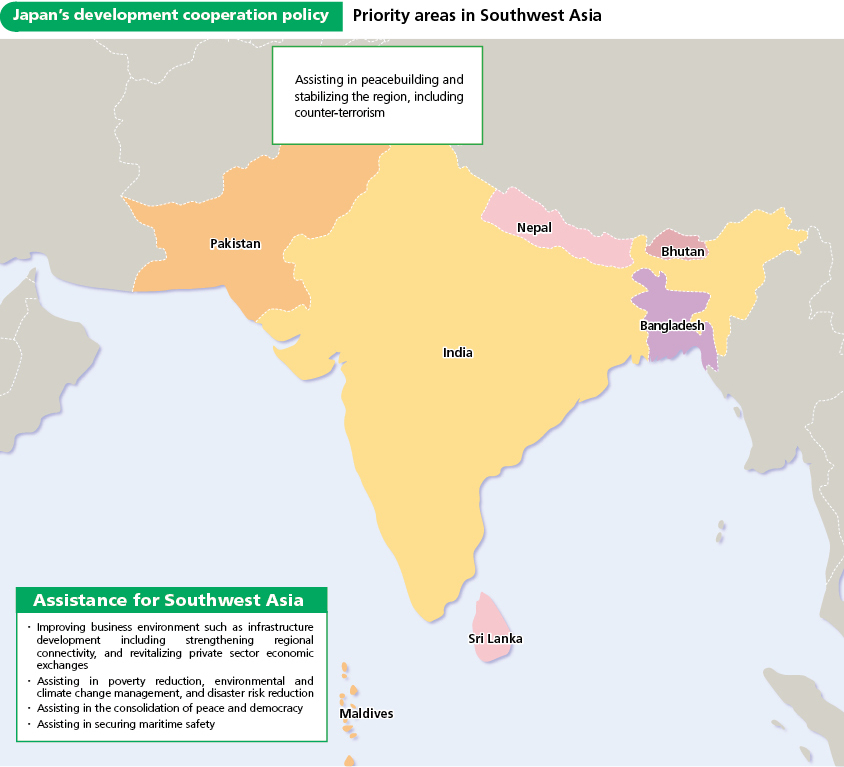
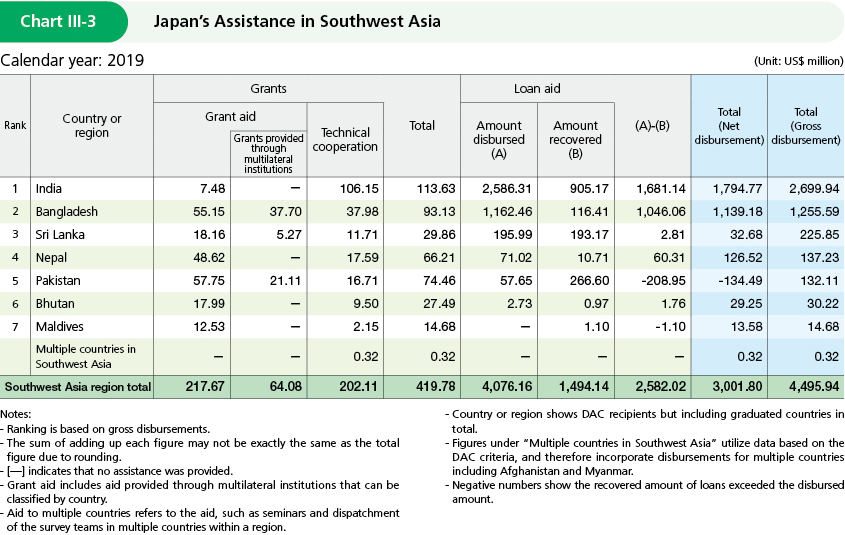
Bangladesh
Project for Construction of the Primary Health Care Clinic in the Camp of Displaced People from Myanmar in Cox’s Bazar
Grant Assistance for Grass-Roots Human Security Projects (March 2019 – March 2020)
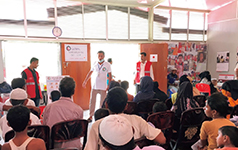
Healthcare staff members working at the newly constructed primary health care clinic (Photo: Bangladesh Red Crescent Society)

The primary health care clinic constructed through this project
In August 2017, a large-scale armed attack broke out in the northern part of Rakhine State in Myanmar. At that time, many displaced people moved across the border into Bangladesh, and approximately 850,000 people* are currently still living in the Cox’s Bazar District of Bangladesh.
One of the camps for displaced persons located in the Ukhia Upazila, Cox’s Bazar frequently experienced floods during the rainy season and cyclones due to its topography, and the steep sloping area to the north of the camp was at high risk of landslides. The damage from these floods degraded the sanitary conditions in the camp and increased the risk of diseases such as cholera and dengue fever.
The Bangladesh Red Crescent Society conducted simple surgical operations, prenatal care including mental healthcare, and awareness-raising activities to promote good health in the camps. However, each healthcare service, such as treatment and surgery, was offered in a different tent, so patients were forced to move from one tent to another in the middle of treatment, which placed a heavy physical burden on them. In addition, parts of the facilities became unusable when it rained and soil flowed in.
In order to improve this situation, the Bangladesh Red Crescent Society constructed a new primary health care clinic that is resistant to floods through Grant Assistance for Grass-Roots Human Security Projects. This has not only made it possible to provide healthcare services in one centralized location, but has also improved the safety of the healthcare facilities, enabling as many as 2,600 patients per month to receive proper healthcare when necessary.
Japan will continue to provide small-scale, yet community-based humanitarian assistance to promote human security.
*Source: UNHCR (October 2020)
https://data2.unhcr.org/en/situations/myanmar_refugees
- Note 5: Source: World Bank website (note that Afghanistan is included in South Asia).
https://www.worldbank.org/ja/country/japan/brief/south-asia (Japanese only)
https://www.worldbank.org/en/news/press-release/2018/09/19/decline-of-global-extreme-poverty-continues-but-has-slowed-world-bank - Note 6: An effort to consume domestic agriculture, forestry, and fishery products in the regions they were produced.
